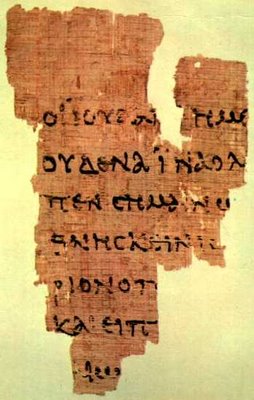History of the Diæresis
 Rather than leaping into a search for the best way to keyboard Coptic, I have decided to step back and examine each of the three necessary diacritics in the Coptic alphabet first. These three are the diaeresis, the overline denoting a nomina sacra or abbreviation, and the jinkim which looks like a macron and gives the consonant a syllabic quality. There are other diacritics but these three occur most often in the manuscripts and have such a diverse and obscure history that I think I will start here and not worry about the others for now.
Rather than leaping into a search for the best way to keyboard Coptic, I have decided to step back and examine each of the three necessary diacritics in the Coptic alphabet first. These three are the diaeresis, the overline denoting a nomina sacra or abbreviation, and the jinkim which looks like a macron and gives the consonant a syllabic quality. There are other diacritics but these three occur most often in the manuscripts and have such a diverse and obscure history that I think I will start here and not worry about the others for now.The papyri in this image, P52, represents the earliest dated instance of the diaresis that I have been able to find. This fragment is a portion of the crucifixion story and is dated 125 - 150 CE.
In this case the diaeresis is at the beginning of a word. In the second line the text reads 'oudena ina' and the diaeresis serves to indicate that the 'i' is pronounced separately from the 'a'. It actually begins a new word and new clause. There also appears to be a trace of a diaereis on the third letter of the top line.
This is the only discussion of the early history of the diaresis that I have found.
- [U]ndoubtedly the occurrence of diaeresis and the omission of iota adscript can be used as criteria of date and, comparatively rare at the beginning of the second century, were increasing in frequency with each successive decade. Statistics for these phenomena do not appear to have been collected (a systematic investigation of the subject might be of some value for palaeography), but such search as it has been possible to make shows that the date assigned to 1 is not affected by them.
The use of diaeresis over i or u was exceedingly rare till the second century, but it was not entirely unknown before then. Originally introduced to distinguish as separately pronounced a vowel accompanying another vowel with which it would otherwise make a diphthong, the usage was soon extended to vowels standing alone, and therefore became meaningless.
It is only the latter use which is relevant to the present case. P. Fay. 110 (A.D. 94) contains in euu`perbaton (l. 9) and twi i`diwi (l. 2) instances of diaeresis which, though an extension of the original use, cannot be regarded as wholly incorrect, since adjoining vowels are being distinguished; but i`na (ibid., 11.6, 9) is a clear case of the incorrect use, dusi u`dasi (l. 17) is at best a further extension of the use in euu`perbaton and twi i`diwi.
Systematic search might perhaps reveal other early examples, but so far as the statistics collected are concerned there are none in exactly dated documents before A.D. 110. (From Fragments of an Unknown Gospel )
I have also scanned through pages of prechristian papyri without finding the shadow of a diaeresis. I would love to hear more about this history and earlier diaereses if they exist.
Update: I misspelled diaeresis in the title and almost left it but 'diaresis' doesn't google as well as
'dieresis' or 'diaeresis.'

8 Comments:
Um, isn't it actually neither diereris nor diaeresis but diæresis?
You are absolutely right. I had no idea that diæresis would google, but I have just tried it and it gives exactly the same hits as diaeresis. That's amazing. Google reads æ as if it were ae.
Thanks for getting me to check this out.
Now, I still don't know it æ would show up in a blog title. My impression is that the title line in blogger is very limited in what it will display. However, I shall have to try it sometime.
Thanks, Suzanne! Google most probably uses some sort of normalisation for ligatures; one would guess users would expect searches for "diæresis" to return pages containing "diaeresis", and vice-versa. I know Google does other things too, like stemming.
And if the æ ligature doesn't show up in blogger titles, that's a Unicode bug in blogger.
This comment has been removed by a blog administrator.
I decided that there was no time like the present. I have edited the title and here is the URL for this post - no ae ligature.
http://abecedaria.blogspot.com/2006/04/history-of-diresis.html
The æ might just as well not exist. Is that a bug in blogger or what - I have no idea.
Hmm ... as programmers would say, it's probably a feature and not a bug :-)
The ligature shows up in the title of the post on the front page, as well as in the ATOM feed. It's only the URI that lacks the ligature. Google probably decided that complex Unicode characters were not safe in URIs since they make break older browsers. I remain ambivalent about their decision, but since it shows up correctly in other places, it's probably deliberate.
It looks like you read Tamil, so here's an example of a blogspot-hosted Tamil blog. Notice how the URIs are all generic (since all posts seem to have Tamil titles, if you strip off non-ASCII characters, you get nothing :-))
http://tamilnithi.blogspot.com/2006/02/blog-post_27.html
Buy Viagra Online
This feature should not be difficult to implement, just a question of time and motivation.
Post a Comment
<< Home